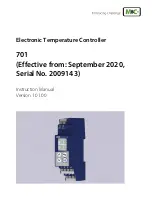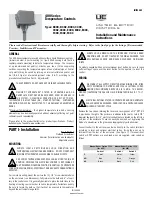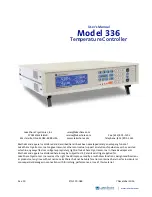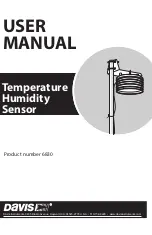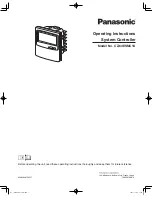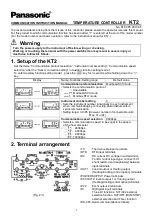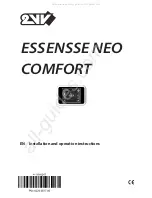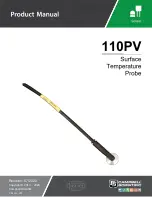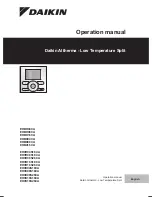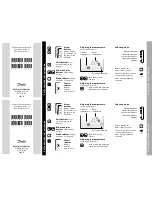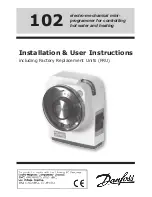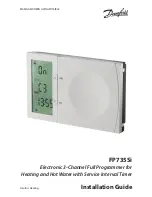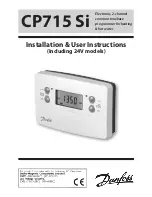
SS-400-002 1 I56-3321-000
MIX-5251APA, MIX-5251RAPA and MIX-5251HAPA
Intelligent Plug-In Temperature Sensors
INSTALLATION AND MAINTENANCE INSTRUCTIONS
25 Interchange Way,
Vaughan,Ontario L4K-5W3
905-660-4655, FAX: 905-660-4113
BEFORE INSTALLING
This sensor must be installed in compliance with the control panel system
installation manual. The installation must meet the requirements of the Au-
thority Having Jurisdiction (AHJ). Sensors offer maximum performance when
installed in compliance with CAN/ULC-S524.
Please read the system wiring and installation manual thoroughly. This man-
ual provides detailed information on sensor spacing, placement, zoning, and
special applications. Copies of these manuals are available from Mircom.
GENERAL DESCRIPTION
Models MIX-5251APA, MIX-5251RAPA and MIX-5251HAPA are intelligent
sensors that utilize a state-of-the-art thermistor sensing circuit for fast re-
sponse. These sensors are designed to provide open area protection with
50 foot spacing capability as approved by ULC. Model MIX-5251APA is a
fixed temperature sensor with 135°F fixed temperature alarm. Model MIX-
5251RAPA is a rate-of-rise temperature sensor with 135°F fixed temperature
alarm. Model MIX-5251HAPA is a high temperature sensor with 190°F fixed
temperature alarm.
Two LEDs on each sensor light to provide 360° visibility of the sensor indica-
tion. The LEDs can be latched ON by code command from the panel for an
alarm indication. The LEDs can also be unlatched to the normal condition
by code command. Remote LED annunciator capability is available as an
optional accessory (Part No. RA400ZA/RA100ZA).
Models MIX-5251APA, MIX-5251RAPA and MIX-5251HAPA require com-
patible addressable communications to function properly. Connect
these sensors to listed-compatible control panels only.
WIRING GUIDE
All wiring must be installed in compliance with the Canadian Electrical Code,
applicable local codes and the Authority Having Jurisdiction. Proper wire
gauges should be used. The installation wires should be color coded to limit
wiring mistakes and ease system troubleshooting. Improper connections will
prevent a system from responding properly in the event of a fire.
Remove power from the communication line before installing sensors.
1. Wire the sensor base (supplied separately) per the wiring diagram, see
Figure 1.
2. Set the desired address on the sensor address switches, see Figure 2.
3. Install the sensor into the sensor base. Push the sensor into the base
while turning it clockwise to secure it in place.
4. After all sensors have been installed, apply power to the control unit and
activate the communication line.
5. Test the sensor(s) as described in the TESTING section of this manual.
TAMPER RESISTANCE
The sensor bases have a tamper-resistant capability. When this capability is
enabled, sensors cannot be removed from the base without the use of a small
screwdriver or other similar tool. Refer to the sensor base installation instruc-
SPECIFICATIONS
Diameter:
6.1 inches (155 mm) installed in B210LPA; 4.1 inches (104 mm) installed in B501A
Height:
2.0 inches (51 mm)
Weight:
4.8 ounces (137 gm)
Installation Temperatures:
–4°F to 100°F (–20°C to 38°C); MIX-5251APA and MIX-5251RAPA; –4°F to 150°F (–20°C to 66°C); MIX-5251HAPA
Operating Humidity Range:
10% to 93% Relative Humidity Non-condensing
Mounting:
B210LPA flanged base; B501A flangeless base
Voltage Range:
15 to 32 Volts DC Peak
Standby Current:
300 µA @ 24 VDC (one communication every 5 seconds with LED blink enabled)
LED Current:
6.5 mA @ 24 VDC
Fixed Temperature Rating:
135°F (57°C); MIX-5251APA and MIX-5251RAPA; 190°F (88°C); MIX-5251HAPA
Rate of Rise Detection:
Responds to greater than 15°F/min.; MIX-5251RAPA
tion manual for details in using this capability.
TESTING
Before testing, notify the proper authorities that the system is undergoing
maintenance, and will temporarily be out of service. Disable the system to
prevent unwanted alarms.
All sensors must be tested after installation and periodically thereafter. Test-
ing methods must satisfy the Authority Having Jurisdiction (AHJ). Sensors
offer maximum performance when tested and maintained in compliance with
CAN/ULC-S536. The sensor may be tested in the following ways:
A. TEST MAGNET (MODEL NO. M02-04)
1. Place the magnet against the cover in the magnet test area as
shown in Figure 3 to activate the test feature.
2. The LEDs should latch ON within 10 seconds, indicating alarm and
annunciating the panel.
3. Reset the detector at the system control panel.
B. DIRECT HEAT METHOD (HAIR DRyER OF 1000 – 1500 WATTS)
1. From the side of the detector, direct the heat toward the sensor. Hold
the heat source about 6 inches (15cm) away to prevent damage to
the cover during testing.
2. The LEDs on the detector should light when the temperature at the
detector reaches the alarm set point. If the LEDs fail to light, check
the power to the detector and the wiring in the detector base.
3. Reset the detector at the system control panel.
Detectors that fail these tests should be cleaned as described under MAIN-
TENANCE and retested. If the detectors still fail these tests they should be
returned for repair.
MAINTENANCE
NOTE: Before cleaning notify the proper authorities that the system is un-
dergoing maintenance, and therefore the system will temporarily be out of
service. Disable the loop or system undergoing maintenance to prevent un-
wanted alarms.
It is recommended that the sensor be removed from its mounting base for
easier cleaning and that sensors be cleaned at least once a year. Use a vac-
uum cleaner to remove dust from the sensing chamber.
firealarmresources.com



